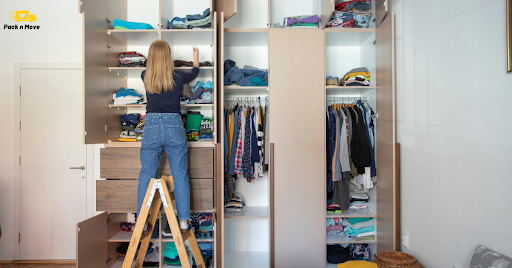Moving house can feel overwhelming, but with a bit of planning and the right strategies, you can turn it into a smooth, stress-free process. One of the best ways to reduce the chaos of moving is by decluttering before you pack up your belongings. Decluttering not only makes the packing process easier, but it can also help you save money, reduce stress, and give you a fresh start in your new home.
Why Decluttering Before Moving is a Game-Changer
Before you start packing, it’s important to recognize the numerous benefits of decluttering. First, decluttering helps organize your home, making it easier to manage during the moving process. By eliminating unwanted household junk, you will have fewer items to pack, which can translate into lower moving costs. For example, the fewer boxes you have, the less expensive your removal company’s rates will be.
Moreover, decluttering provides an emotional benefit. It’s a chance to start fresh and leave behind things that no longer serve a purpose. When you walk into your new home, you want it to feel like a clean slate, and part of that means only bringing what you truly need. Decluttering can also help you focus on what’s important by freeing up physical and mental space.
Start Early and Plan Smart
One of the key steps to a stress-free move is starting early. Don’t wait until the last minute to declutter your home. Instead, create a moving to-do list and break it down into smaller tasks. This could mean decluttering one room per week or focusing on one category of items at a time, such as clothes, furniture, or books.
Setting a timeline is also essential to avoid feeling rushed as your moving date nears. You’ll want to give yourself enough time to sort through everything, make decisions about what stays and what goes, and organize everything in a way that makes sense for the move. Keep your moving house checklist updated and track your progress as you go.
Visualize Your New Space
A common mistake people make when moving is not taking the time to visualize how their belongings will fit into the new home. Before you even start packing, take a walk through your new home (or look at the floorplan) and think about where everything will go. Whether you have a double walk-in closet or a single bedroom closet, planning where each item will fit can help you decide what to keep and what to leave behind.
Take pictures or videos of the new space and use them to guide your decluttering process. For example, you may realize that your current kitchenware won’t fit in the new space or that you have more linens than you’ll ever need. Visualizing your new home in advance can help you make informed decisions about what to pack.
Tackle One Area at a Time

Decluttering can feel like a massive task, but breaking it down into smaller sections makes it more manageable. Focus on one area of your home at a time, whether it’s the living room, bathroom, or garage. This allows you to stay organized and not feel overwhelmed by the amount of work to be done.
Start by tackling the areas you use the least. For example, if you rarely use your attic or garage, start there. As you move through your home, be mindful of what you use on a daily basis and what’s just taking up space. By the end of the process, you’ll feel a sense of accomplishment and clarity.
Assess the Condition and Value of Items
When decluttering, it’s essential to assess the condition and value of each item. Are your furniture pieces still in good shape, or have they seen better days? Are your clothes still wearable, or are they worn out and outdated? As you go through your possessions, ask yourself if each item is useful, functional, or holds sentimental value.
For example, when sorting through sentimental items, consider if you need to keep every item or if it’s enough to preserve the memories without holding onto physical objects. You may even want to consider digitalizing photos or documents to reduce the clutter without losing the memories attached to them.
Master the Art of Letting Go
One of the hardest parts of decluttering is deciding what to keep and what to toss. To make this process easier, consider popular decluttering methods such as the Marie Kondo method or the 20/20 rule. The Marie Kondo method suggests you ask yourself if an item sparks joy before deciding whether to keep it. The 20/20 rule, on the other hand, says that if an item can be replaced for under 20 pounds and within 20 minutes, it’s probably best to let it go.
By following these methods, you can make decisions more quickly and avoid second-guessing yourself. Remember, letting go of things doesn’t mean you’re losing part of yourself; it’s about making room for the things that truly matter.
Address Sentimental Items Strategically
Sentimental items can be the hardest to part with during a decluttering session. These may include family heirlooms, childhood keepsakes, or personal mementos. However, it’s important to address them in a way that doesn’t contribute to clutter. Try setting aside a separate box for sentimental items, but be selective. Instead of holding onto every item, preserve the most meaningful pieces and consider donating or selling the rest.
For example, you might find that your old home has several boxes of childhood drawings or family photos. While these hold sentimental value, you may not need to keep every single item. By carefully curating your collection of keepsakes, you can save space while still cherishing the memories.
Donate, Sell, or Rehome Unwanted Items
Once you’ve sorted through your belongings, it’s time to decide what to do with the items you no longer need. Consider donating gently used items to local charity shops such as the British Heart Foundation or Furnishing Futures, which may even pick up furniture and larger items. Alternatively, you can sell unwanted items through platforms like eBay, Depop, or Gumtree. If you’re looking to downsize quickly, a garage sale is a great way to get rid of items fast.
If some items don’t have immediate resale value but are still in good condition, try giving them away via Freecycle or a local community group. Just make sure to get rid of things before you move to avoid cluttering up your new home.
Create an Essentials Box
One of the most important tips for a smooth move is to pack an essentials box. This box should contain everything you need for the first few days in your new home, such as towels, toiletries, medications, cleaning tools, and a few basic kitchen items like mugs, plates, and utensils. Having everything in one box will save you time and energy as you settle in and avoid rummaging through boxes to find everyday essentials.
Use Temporary Storage for Oversized or Uncertain Items
If you’re unsure about some of your belongings or have items that won’t fit immediately in your new home, consider using a temporary storage unit. This is particularly helpful for larger items like furniture or collections of books that you’re not ready to part with yet. Self-storage facilities offer a convenient way to keep your belongings safe and accessible until you have more time to figure out what to do with them.
Save Money While Decluttering

Decluttering before a move can also save you money. Not only will you reduce your moving expenses by having fewer items to transport, but you might also make a bit of cash by selling unwanted items. Consider how much you can save by getting rid of things you no longer use. Plus, by donating items to charities like Food Banks or The British Heart Foundation, you’ll be supporting great causes while lightening your load.
Conclusion
Decluttering before moving house isn’t just about clearing out old stuff; it’s about creating a fresh start. By planning ahead, tackling one area at a time, and being strategic about what you keep, you can make your move much easier. Whether it’s donating, selling, or using temporary storage, the key is to lighten your load and focus on what truly matters. Take your time, stay organized, and soon you’ll be settled into your clutter-free home in no time.
Frequently Asked Questions (FAQs)
How do I start decluttering before moving?
Start early by making a moving checklist and tackling one room at a time. Focus on areas you use the least and gradually work your way through your home.
What should I do with sentimental items?
Set aside a box for sentimental items, but be selective. Consider preserving memories by taking photos or digitalizing keepsakes.
How can I sell unwanted items quickly?
Use platforms like eBay, Depop, or organize a garage sale to sell your items. You can also donate to local charity shops if you prefer not to sell.
What is the Marie Kondo method?
The Marie Kondo method encourages you to keep only the items that “spark joy.” It’s a great way to declutter without feeling guilty about letting things go.
How can I save money during the move?
Declutter before moving to reduce the number of items you need to transport. You can also save by selling or donating items instead of moving them to your new home.
